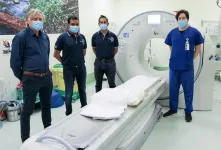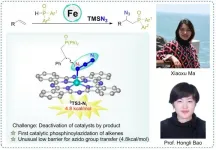New insights into Salmonella's survival strategies
EMBL scientists shed light on how Salmonella hijacks the machinery of its host cell to promote its own growth and reproduction
2021-07-07
(Press-News.org) Our cells fight microbial invaders by engulfing them into membrane sacs - hostile environments in which pathogens are rapidly destroyed. However, the pathogen Salmonella enterica, which grows and reproduces inside our cells, has evolved ways to detoxify such hostile compartments, turning them into a comfortable home where Salmonella can survive and thrive.
A team of scientists led by EMBL group leader Nassos Typas has uncovered new details of Salmonella´s survival strategies. The researchers analysed protein interactions in Salmonella-infected cells to identify the diverse biological processes of the host cell that the bacterium uses. Salmonella targets and modifies cellular protein machineries and pathways, in which multiple proteins work together, with the help of so-called effector proteins, which it injects into host cells. Altogether, Salmonella is known to release more than 30 effector proteins into infected cells to hijack nutrients and protect itself. However, the functions of many of these proteins, and which host cell proteins they interact with, are largely unknown.
To find these enigmatic protein interactions, the EMBL scientists genetically engineered 32 Salmonella strains by adding identification tags to individual Salmonella proteins - earmarking one protein in each bacterial strain. The identification tags act like a handle the scientists can grab in their experiments. This approach of modifying the effector proteins directly in their host is a breakthrough. It enables researchers to capture the bacterial proteins after they have been secreted into infected cells, and to pull them out along with any host cell proteins that are bound to them. These interacting proteins are then identified using a technique called mass spectrometry.
"The new approach has many benefits over previous experimental strategies. In particular, it characterises the whole set of host-pathogen protein-protein interactions in cells infected with a live pathogen, closely resembling what occurs in a host organism upon Salmonella infection,"says Joel Selkrig, a scientist in the Typas group and one of the two lead authors of the study.
Using their novel approach, the EMBL scientists identified 421 previously unknown interactions between Salmonella proteins and host cell proteins - along with 25 interactions that had been described before.
"We found that multiple Salmonella effectors physically interact with several proteins that the host cell uses to transport cholesterol. This way, cholesterol trafficking can be hijacked for Salmonella´s own purposes," says Philipp Walch, who recently completed his PhD at EMBL Heidelberg and shares first authorship of the study with Joel.
Cholesterol is an essential component of the biological membranes that surround our cells and the structures within them. Salmonella uses cholesterol to modify the composition of the membrane sacs that surround it, potentially making the membrane more rigid and reinforcing the barrier that separates Salmonella from cellular detection and defence systems, which are present in the host cell´s cytoplasm.
The scientists also found new clues to how two other survival strategies work. One of these strategies is to remodel the network of protein fibres that are used to transport material within the cell. Another strategy involves interfering with the function of a host cell protein that mediates contacts between membranes to facilitate the exchange of lipids and small molecules. Both strategies may help Salmonella to strengthen its protective membrane shield and avoid detection by the host cell´s defence systems.
The recent results follow research published by the Typas group in 2020, in which the researchers described how Salmonella infection can lead to an inflammatory form of cell death. The current study involved scientists from EMBL and colleagues from Imperial College London, UK; the Helmholtz Centre for Infection Research in Braunschweig, Germany; and Rocky Mountain Laboratories in Hamilton, Montana, USA - part of the National Institute of Allergy and Infectious Diseases.
INFORMATION:
[Attachments] See images for this press release:

ELSE PRESS RELEASES FROM THIS DATE:
2021-07-07
Scientists from Trinity College Dublin are homing in on a recipe that would enable the future production of entirely renewable, clean energy from which water would be the only waste product.
Using their expertise in chemistry, theoretical physics and artificial intelligence, the team is now fine-tuning the recipe with the genuine belief that the seemingly impossible will one day be reality.
Initial work in this area, reported just under two years ago, yielded promise. That promise has now been amplified significantly in the exciting work just published in leading journal, Cell Reports Physical Science.
Energy ...
2021-07-07
Researchers from North Carolina State University have developed a patch that plants can "wear" to monitor continuously for plant diseases or other stresses, such as crop damage or extreme heat.
"We've created a wearable sensor that monitors plant stress and disease in a noninvasive way by measuring the volatile organic compounds (VOCs) emitted by plants," says Qingshan Wei, co-corresponding author of a paper on the work. Wei is an assistant professor of chemical and biomolecular engineering at NC State.
Current methods of testing for plant stress or disease involve taking plant tissue samples and conducting an assay in a lab. However, this ...
2021-07-07
The Hikurangi Margin, located off the east coast of the North Island of New Zealand, is where the Pacific tectonic plate dives underneath the Australian tectonic plate, in what scientists call a subduction zone. This interface of tectonic plates is partly responsible for the more than 15,000 earthquakes the region experiences each year. Most are too small to be noticed, but between 150 and 200 are large enough to be felt. Geological evidence suggests that large earthquakes happened in the southern part of the margin before human record-keeping began.
Geophysicists, geologists, and geochemists from throughout the world have been working together to understand why this plate boundary behaves as it does, producing both imperceptible silent earthquakes, but also potentially major ...
2021-07-07
Reston, VA--For patients with pancreatic ductal adenocarcinomas (PDAC), molecular imaging can improve staging and clinical management of the disease, according to research published in the June issue of The Journal of Nuclear Medicine. In a retrospective study of PDAC patients, the addition of PET/CT imaging with 68Ga-FAPI led to restaging of disease in more than half of the patients, most notably in those with local recurrence.
PDAC is a highly lethal cancer, with a five-year survival rate of less than 10 percent. Optimal imaging of PDAC is crucial for accurate initial TNM (tumor, node, metastases) staging and selection ...
2021-07-07
Dancing with music can halt most debilitating symptoms of Parkinson's disease
First-of-its-kind York U study shows participating in weekly dance training improves daily living and motor function for those with mild-to-moderate Parkinson's
TORONTO, July 7, 2021 - A new study published in Brain Sciences today, shows patients with mild-to-moderate Parkinson's disease (PD) can slow the progress of the disease by participating in dance training with music for one-and-a-quarter hours per week. Over the course of three years, this activity was found to reduce daily motor issues such as those related to balance and speech, ...
2021-07-07
When a head of state or government official travels to another country to meet with his/her counterpart, the high-level visit often entails a range of public diplomacy activities, which aim to increase public support in the host country. These activities often include events such as hosting a joint press conference, attending a reception or dinner, visiting a historic site, or attending a social or sports event. A new study finds that public diplomacy accompanying a high-level visit by a national leader increases public approval in the host country. The findings are published in the American Political ...
2021-07-07
The Arctic is warming at approximately twice the global rate. A new study led by researchers from McGill University finds that cold-adapted Arctic species, like the thick-billed murre, are especially vulnerable to heat stress caused by climate change.
"We discovered that murres have the lowest cooling efficiency ever reported in birds, which means they have an extremely poor ability to dissipate or lose heat," says lead author Emily Choy, a Postdoctoral Fellow in the Natural Resource Sciences Department at McGill University.
Following reports of the seabirds dying in their nests on sunny days, the researchers trekked the cliffs ...
2021-07-07
Data from nine cities in Mexico confirms that identifying dengue fever “hot spots” can provide a predictive map for future outbreaks of Zika and chikungunya. All three of these viral diseases are spread by the Aedes aegypti mosquito. Lancet Planetary Health published the research, led by Gonzalo Vazquez-Prokopec, associate professor in Emory University’s Department of Environmental Sciences. The study provides a risk-stratification method to more effectively guide the control of diseases spread by Aedes aegypti. “Our results can help public health officials to do targeted, proactive interventions ...
2021-07-07
Prostate cancer is the most diagnosed cancer and a leading cause of death by cancer in Australian men.
Early detection is key to successful treatment but men often dodge the doctor, avoiding diagnosis tests until it's too late.
Now an artificial intelligence (AI) program developed at RMIT University could catch the disease earlier, allowing for incidental detection through routine computed tomography (CT) scans.
The tech, developed in collaboration with clinicians at St Vincent's Hospital Melbourne, works by analysing CT scans for tell-tale signs of prostate ...
2021-07-07
Phosphinoylazidation of alkenes is a direct method to build nitrogen- and phosphorus-containing compounds from feedstock chemicals. Notwithstanding the advances in other phosphinyl radical related difunctionalization of alkenes, catalytic phosphinoylazidation of alkenes has not yet been reported. Thus, efficient access to organic nitrogen and phosphorus compounds, and making the azido group transfer more feasible to further render this step more competitive remain challenging.
Recently, a research team led by Prof. Hongli Bao from Fujian Institute of Research on the Structure of Matter, Chinese Academy of Sciences (CAS) reported the first iron-catalyzed phosphinoylazidation of alkenes under ...
LAST 30 PRESS RELEASES:
[Press-News.org] New insights into Salmonella's survival strategies
EMBL scientists shed light on how Salmonella hijacks the machinery of its host cell to promote its own growth and reproduction






